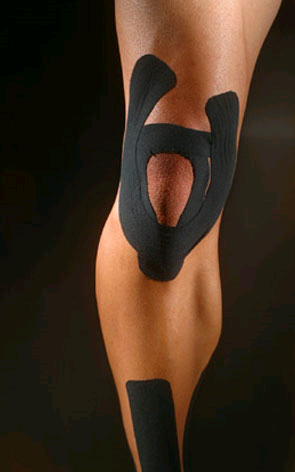Kinesio tape is applied over muscles to reduce pain and inflammation, relax overused or tired muscles, and support muscles in movement on a 24-hour-a-day basis. The taping is non-restrictive and allows for full range of motion. In contrast, more traditional sports tape is wrapped around a joint strictly for stabilization and support during an athletic event. Kinesio® Tex Tape is used to treat anything from headaches to foot problems and everything in between. Just a few examples include rehabilitation from sports injuries, carpal tunnel syndrome, lower back strain/pain (subluxation, herniated disc), knee and shoulder conditions. There are many more.
Kinesio Tape is made of 100% high grade cotton so it is comfortable and breathable. The 140% elasticity mimics the flexibility of human skin and muscles. The adhesive is heat-activated, light, mild and hypo-allergenic, causing less skin sensitivity or irritability than other tapes. Kinesio® Tex Tape is completely latex-free and the unique wave design keeps it air-permeable as it microscopically lifts skin and channels away moisture. It is also quite durable and comfortable enough to be left on for 3 to 5 days per application. An average of 8 to10 applications per roll of tape makes it economical as well.


Available in various colors: pink, blue, black, and beige Benefits:
Decreased healing time
Decreased swelling and bruising
Multiple day support
Reduction in skin sensitivity
Decreased joint pain
Decrease spastic muscle
Improve posture
Recently the NCAA Mens 100 meter record was broken by Ngoni Makusa of Florida State at the National Championship meet with the assistance of kinesio tape.
Watch it here: Click here. Best seen at the 1:10-1:25 mark.
"This information and website content is not intended to diagnose, guarantee results, or recommend specific treatment or activity. It is designed to educate and inform only. Please consult your physician for a thorough examination leading to a diagnosis and well-planned treatment strategy. See more details on the
DISCLAIMER page. Content is reviewed by
Dr. James M. Cox I."